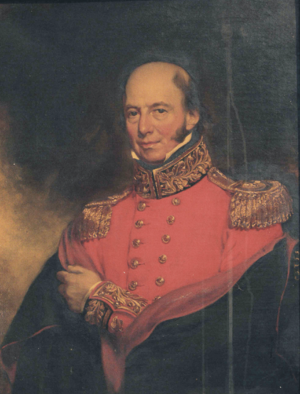William Loftus (British Army officer) facts for kids
Quick facts for kids
General William Loftus
|
|
|---|---|

Painted by Samuel Lane ca. 1804
|
|
| Born | 1752 |
| Died | 15 July 1831 |
| Allegiance | United Kingdom |
| Service/ |
British Army |
| Rank | General |
| Battles/wars | American War of Independence, Battle of Bunker Hill, New York and New Jersey campaign, Battle of Long Island, Landing at Kip's Bay, Battle of Pell's Point, Battle of White Plains, Battle of Fort Washington. Irish Rebellion of 1798, Battle of Vinegar Hill. |
General William Loftus (born 1752, died 1831) was an important officer in the British Army. He also served as a Member of Parliament, which means he helped make laws for the country. He fought in some big wars, like the American War of Independence and the Irish Rebellion of 1798.
Contents
Early Life and Military Start
William Loftus was born in 1752 in a place called Raynham in Norfolk, England. His family had a long history, and his ancestor, Archbishop Adam Loftus, was buried in St. Patrick's Cathedral in Dublin.
When William was 18, his father bought him a special position in the army. This was in the 17th Regiment of (Light) Dragoons in Ireland. This regiment was sent to North America in 1775. There, William Loftus took part in the American War of Independence. He stayed there for almost three years before returning to Ireland.
Rising Through the Ranks
William Loftus was a very successful soldier. He kept getting promoted to higher ranks. In 1796, he became a major-general. Then, in 1803, he was promoted to lieutenant-general. Finally, in 1813, he became a full General.
He also held important jobs outside of direct combat. From 1807 to 1810, he was the Governor of Dumbarton Castle. After that, he became the Lieutenant of the Tower of London in 1810. From 1821 until he died, he was the Colonel of the 2nd Dragoon Guards (Queen's Bays).
General Loftus passed away peacefully at his home in London on July 15, 1831. He was buried next to his second wife in the family vault at Raynham Hall.
Fighting in the American War of Independence
William Loftus sailed to Boston in April 1775. When he arrived in May, the city was surrounded by American fighters. Just a few weeks later, he volunteered to fight in his first battle at Bunker Hill. This was a very bloody battle.
After a tough winter in Boston, the British army had to leave the city in March 1776. Loftus then helped build forts in Halifax, Nova Scotia.
Key Battles and Close Calls
In July 1776, Loftus and his regiment landed on Staten Island. They joined forces with German soldiers called Hessians. Loftus showed great bravery in his first command during the Battle of Long Island. He helped push back the Americans and capture some of their generals.
A few weeks later, at Kip's Bay, Loftus had a very close call. He saw General George Washington, the American leader, almost alone. Loftus rode very close to him, almost capturing him! However, American riflemen stopped him. If he had captured Washington, history might have been very different.
Loftus continued to fight bravely. At Pelham Manor, he was chosen to be General Howe's personal guard. At White Plains, he was wounded while leading soldiers across the Bronx River. His injuries were not serious, and he was back fighting the next month at the Battle of Fort Washington.
He was wounded again while defending a pass at Kingsbridge. This was a big defeat for the Americans. Loftus then rested for the winter. He returned to duty in January 1777, destroying American ammunition stores. He also took part in several other battles in New Jersey. Later, he was promoted to captain and went back to Ireland.
Role in the Irish Rebellion
From 1778 to 1783, Loftus served as an aide-de-camp (a personal assistant) to the Lord Lieutenants of Ireland. He made many good friends during this time.
In 1784, he returned to active duty in the 3rd Regiment of Guards and was based in London. In 1794, he created a new army unit called the 24th Light Dragoons.
In 1796, Loftus became a Major General. He also became a Member of Parliament for Ireland and later for Great Yarmouth in England. In 1797, he was put in charge of the army in Munster, Ireland. He reported that most people there wanted "good order and government."
In 1798, Loftus commanded a group of soldiers at the Battle of Vinegar Hill during the Irish Rebellion of 1798. He also oversaw a military trial for a famous rebel leader named Wolfe Tone.
In 1800, Loftus moved back to England. However, he kept his positions in both the Irish and British Parliaments to help pass the Act of Union. This law joined Ireland and Great Britain into one country.
Family Life
William Loftus was married twice. His first wife was Margaret King. They married in 1778 and had two sons and two daughters. Margaret passed away in 1786.
In 1790, he married Lady Elizabeth Townshend. She was the daughter of a very important person, George Townshend, 1st Marquess Townshend. William and Elizabeth had five sons and four daughters together.
Images for kids




